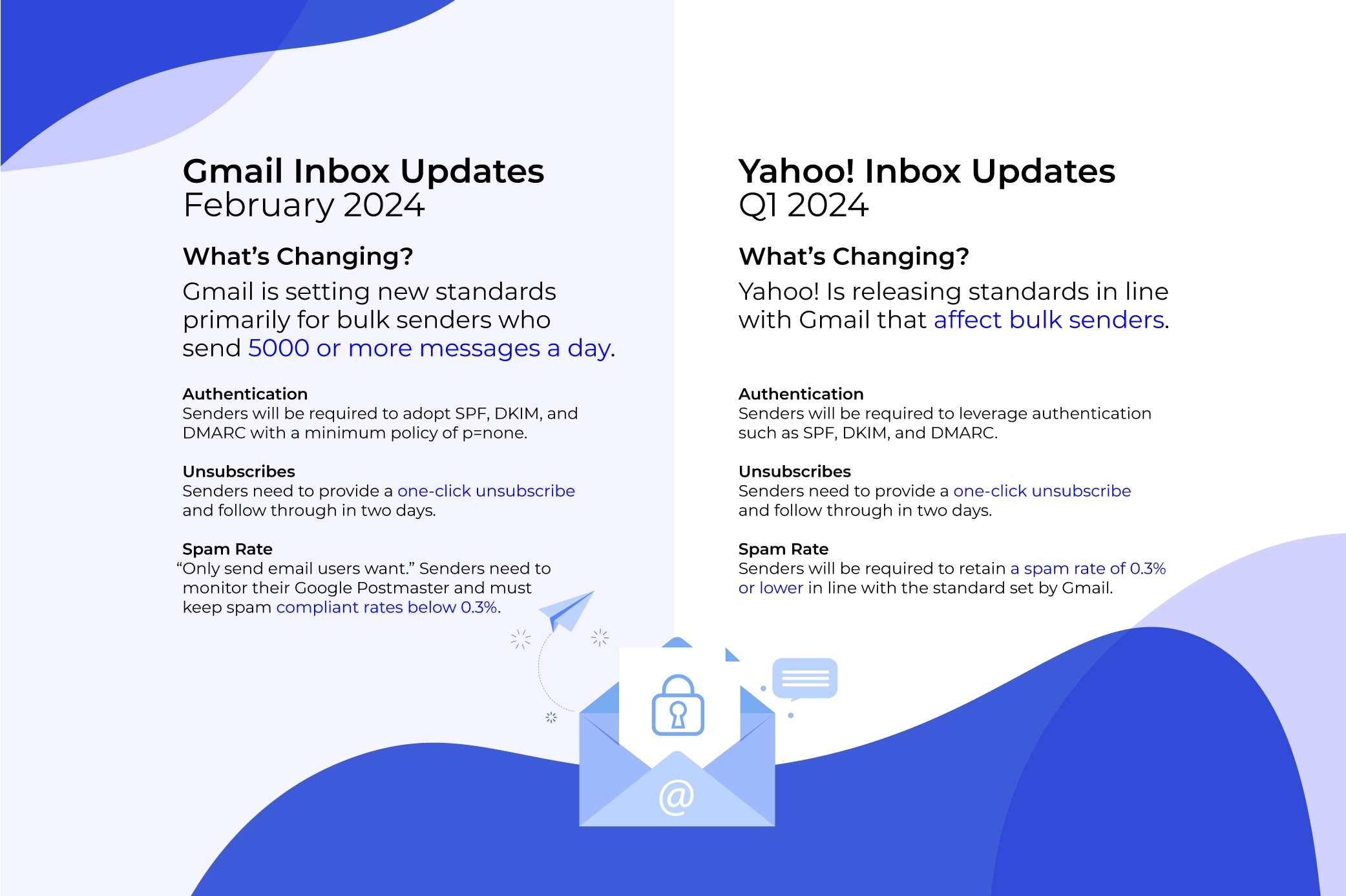Beginning in February 2024, Gmail and Yahoo! are significantly changing their email handling practices. The stricter requirements in the Gmail mail update will also be mirrored in the Yahoo! mail update. Both email providers have implemented these changes to promote responsible email practices and reduce the delivery of spam and other unwanted emails. This helps keep their users’ inboxes safer and reduces spam, offering a better email experience.
To ensure deliverability under these new rules, bulk senders (over 5,000 emails daily) must authenticate their emails, make it easy to unsubscribe, and have a low reported spam threshold.
Gmail & Yahoo! Requirements for Bulk Senders
The new rules require bulk email senders to authenticate their emails, simplify unsubscribing, and stay under a spam threshold of 0.30%. These rules are meant to reduce spam in email inboxes, tighten security, and block malicious messages.

Email Authentication
Gmail and Yahoo! mail updates will now require bulk senders to validate the sender’s identity using SPF, DKIM, and DMARC. Many bulk senders do not secure and configure their systems correctly, leaving openings for bad actors to hide among legitimate senders. Strong authentication that adheres to well-established best practices will reduce the number of unauthenticated emails received and close loopholes exploited by bad actors.
Read more about Gmail best practices for setting up DKIM.
Make Unsubscribing Easier
A prominent unsubscribe link and a clear message about how long it will take to stop getting marketing emails are best practices, so now’s the time to get serious about it. When it’s hard to unsubscribe, recipients are more likely to flag the email as spam.
The rules require a way to unsubscribe one step as an unsubscribe link in the body of the email. That link does not have to be one step, so you can add messaging on how long it will take to no longer receive marketing emails. However, you are required to process unsubscribe requests within two days.
Gmail & Yahoo! Requirements for All Senders
List hygiene fanatics, this is your time to shine. The crackdown on spam will make list hygiene even more important. Before this tightening of the rules due to the Gmail mail update, Gmail would often blacklist emails due to:
- Sending emails to inactive subscribers
- Sending emails to invalid email addresses
- Too many spam complaints
With the rule change, senders with regular spam rates that average 0.30%may find their emails in the bulk folder. Or worse, put in Gmail jail and they may be banned from sending emails – an email marketer’s worst nightmare.
There is no clear guidance on whether a ban will be permanent and how to get unbanned. Google and Yahoo! are expected to put a process in place, but it has yet to be disclosed.
Why risk an interruption to your email program if you can avoid it? All senders should take steps to maintain spam reports in Google Postmaster Tools below 0.10% or less to make sure their emails are successfully delivered. What used to be considered best practices are now requirements to keep your domain out of spam jail. We recommend these steps:
- Perform list hygiene at least once a year, ideally by October 31 to ensure your Holiday emails are delivered
- Ensure you are sending wanted emails with relevant content or offers
- Do not buy email lists or addresses and use double opt-in when collecting contacts
- Segment your lists for more targeted emails
- Increase email personalization
What about Subdomains?
You may be able to reduce the chances of being blacklisted by sending emails from a subdomain. But this is not a good long-term strategy. Eventually, if your subdomain breaks the 0.30% spam complaint threshold, it may affect your entire domain. As best practice, you should follow the same rules outlined above for your subdomain as you do for your domain.
Timeline for Enforcement
Beginning in February 2024, bulk senders who do not comply with the new rules will start to get temporary errors (with error codes) on a percentage of their non-compliant email traffic. These errors intend to help senders identify email traffic that does not meet the new rules so they can bring their email traffic into compliance.
In April 2024, Gmail will start rejecting a percentage of non-compliant email traffic, gradually increasing the rejection rate over time.
Bulk senders will have until June 1, 2024, to implement one-click unsubscribe in all commercial promotional messages.
Read more about the new guidelines in Google’s email sender guidelines FAQ and Yahoo! Email best practices.
These Requirements Will Affect Every Email Sender
These requirements Gmail and Yahoo! mail updates are aimed mainly at bulk senders. Smaller senders and transactional emails may be impacted less but should still comply.
What Gmail and Yahoo! require of large senders will probably be required of all senders in the future. And will most likely be adopted by all email providers. If your B2B transactional emails do not meet this threshold, your entire organization’s emails, including B2C emails, will be banned.
So, no matter how many emails you send — or what type — protecting your domains, keeping your spam complaints low, and following the deliverability best practices outlined above will protect your subscribers and keep your email program healthy.
